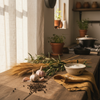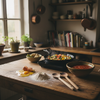Perfect Ladle For Serving Soups: DI OROs Guide
Key Takeaways
- The perfect ladle for serving soups enhances kitchen efficiency and presentation.
- The right ladle ensures precise portion control and prevents splashing.
- Using a proper ladle protects cookware from scratches, especially nonstick surfaces.
- Many home chefs overlook the importance of choosing the appropriate ladle.
Table of Contents
- Ladles Unveiled, Why They're the Unsung Heroes of Your Kitchen
- Sizing Up Success, Features That Make a Ladle Perfect for Soup
- Anatomy of a Great Soup Ladle, Material, Construction, and Design
- Handle to Bowl, Engineering Comfort, Safety, and Control
- Ladle Bowl, Shape, Capacity, and Performance Explained
- Ladle Materials, Comparative Analysis for Home Chefs
- Ladle Selection for Every Scenario, Special Need Focus
- DI ORO's Pro-Grade Difference, Award-Winning Ladles in Practice
- Practical How-To, Using, Cleaning, and Storing Your Ladle
Ladles Unveiled, Why They're the Unsung Heroes of Your Kitchen
The perfect ladle for serving soups transforms chaotic kitchen moments into confident culinary presentations. While most home chefs grab whatever's handy, the right ladle delivers precise portions, prevents splashing, and protects your cookware from scratches, especially crucial with today's nonstick surfaces.
Beyond soups, ladles excel at serving batters for pancakes, transferring sauces without drips, and portioning broths for stock-based dishes. The key lies in capacity: 4-ounce bowls work perfectly for standard soup servings, while 6-ounce versions handle hearty stews and chunky chowders. Professional kitchens rely on 2-ounce ladles for delicate sauce work. For those seeking a versatile upgrade, the 2-piece silicone spoon set is also a smart addition to any kitchen.
What Makes a Soup Ladle Essential?
- Precision Control: Bowl shape and rim design prevent spills during transfer
- Heat Protection: Extended handles keep hands safe from steam and splatter
- Material Safety: Pro-grade silicone protects nonstick coatings while remaining forever-chemical-free
- Portion Consistency: Standardized bowl sizes ensure uniform serving sizes
DI ORO's seamless construction eliminates the food traps and bacteria harboring that plague traditional jointed ladles. When America's Test Kitchen tested kitchen tools for durability and safety, seamless designs consistently outperformed conventional alternatives.
Sizing Up Success, Features That Make a Ladle Perfect for Soup

The perfect ladle for serving soups balances four critical elements: bowl capacity, handle ergonomics, material safety, and heat resistance. Professional-grade ladles withstand temperatures up to 600°F while maintaining structural integrity, a standard that separates quality tools from kitchen drawer casualties.
| Feature | DI ORO Pro-Grade Silicone | Standard Stainless Steel | Traditional Wood |
|---|---|---|---|
| Heat Resistance | 600°F tested | High heat capable | Limited heat tolerance |
| Nonstick Safety | Scratch-free guarantee | Can scratch surfaces | Generally safe |
| Chemical Safety | Forever-chemical-free, LFGB certified | Inert material | Natural but porous |
| Durability | Seamless, lifetime warranty | Prone to handle loosening | Susceptible to cracking |
| Hygiene | Dishwasher safe, no seams | Easy to clean | Hand wash only |
Bowl shape significantly impacts performance. Deep, rounded bowls capture chunky ingredients effectively, while shallow bowls work better for thin broths. Handle length should match your largest pot's depth, typically 11-14 inches for stockpots, 8-10 inches for standard saucepans.
DI ORO's award-winning seamless design, recognized by America's Test Kitchen as the most versatile silicone tool on the market, eliminates the weak points that cause traditional ladles to fail. The steel core provides strength while pro-grade silicone ensures safety and longevity.
For more on the advantages of silicone utensils, see this guide on the silicone ladle and its role in modern kitchens.
Anatomy of a Great Soup Ladle, Material, Construction, and Design
Seamless construction represents the gold standard in ladle design, eliminating the joints where bacteria accumulate and handles eventually loosen. Traditional ladles fail at connection points, where metal meets plastic or where handles attach to bowls. These failure zones compromise both hygiene and durability.
Pro-grade silicone offers unique advantages: flexibility that conforms to pot curves for complete scraping, heat resistance that prevents melting or warping, and chemical inertness that won't leach harmful compounds into food. Unlike conventional silicone, LFGB-certified materials undergo rigorous European safety testing, ensuring zero forever-chemical contamination.
Seamless vs. Conventional Construction
Seamless Design Benefits: No crevices for food particles, uniform heat distribution, single-piece durability, easier cleaning, professional hygiene standards
Conventional Joint Risks: Bacteria accumulation, handle separation, uneven wear patterns, difficult sanitization, shorter lifespan
Visual inspection reveals quality differences immediately. Run your finger along the handle-to-bowl transition, any ridge, gap, or texture change indicates potential failure points. Quality ladles feel substantial without excessive weight, balance naturally in your hand, and show no visible seams or attachment points.
DI ORO's Seamless Series exemplifies this engineering approach, combining stainless steel core strength with pro-grade silicone safety. The result: a tool that performs under pressure, maintains food safety standards, and delivers consistent results across countless soup services.
For those who frequently serve chunky stews or need a tool for scraping, the Seamless Pro 14-Inch Large Silicone Spatula offers excellent versatility and reach.
Handle to Bowl, Engineering Comfort, Safety, and Control
The perfect ladle for serving soups begins with ergonomic handle design that prevents fatigue during extended cooking sessions. Professional-grade handles feature contoured grips, anti-slip textures, and optimal length ratios that provide leverage without sacrificing control. Heat-resistant coatings protect hands from steam and splashes, while proper weight distribution reduces wrist strain during repetitive serving motions.
Handle length directly impacts safety and functionality. Stockpot ladles require 11-14 inch handles for safe reach, while standard saucepan service works best with 8-10 inch handles. DI ORO's ergonomic design incorporates these professional standards, featuring heat-resistant silicone grips that remain cool even during high-temperature cooking. The seamless construction eliminates weak points where traditional handles might loosen or break under stress.
Storage and safety features enhance daily usability. Integrated hanging loops allow for convenient storage while keeping ladles within easy reach. Anti-roll designs prevent ladles from sliding across countertops, and balanced weight distribution ensures stable resting when placed across pot rims. These engineering details transform routine soup service from a potential hazard into a controlled, professional experience.
Ladle Bowl, Shape, Capacity, and Performance Explained

Bowl geometry determines serving precision and portion control. Deep, rounded bowls excel with chunky soups and stews, capturing solid ingredients alongside liquid. Shallow, wide bowls work better for thin broths and consommés, providing quick filling and smooth pouring. The ideal soup ladle bowl holds 4-6 ounces, sufficient for proper portion sizes without creating unwieldy weight when full.
Pour spout design prevents drips and ensures clean presentation. Professional ladles feature subtle rim modifications that channel liquid flow, eliminating the trailing drops that mar table settings. Flexible bowl edges, particularly in pro-grade silicone models, conform to pot curves for complete liquid recovery. This flexibility proves especially valuable when serving expensive stocks or carefully crafted bisques where every drop matters.
| Bowl Type | Capacity | Best For | Pour Control |
|---|---|---|---|
| Deep Round | 6-8 oz | Chunky stews, chowders | Moderate |
| Standard Soup | 4-6 oz | Most soups, everyday use | Excellent |
| Shallow Wide | 3-4 oz | Thin broths, sauces | Superior |
| Flexible Silicone | 4-6 oz | All soup types, nonstick pots | Excellent |
Bowl flexibility offers practical advantages beyond nonstick compatibility. Silicone bowls conform to pot contours, scraping clean even rounded Dutch ovens and stockpots. This conforming action recovers more soup per serving session and simplifies cleanup by preventing residue buildup in pot corners.
For more on utensils that excel at draining and serving, explore the slotted spoon for draining and serving and how it complements your ladle in the kitchen.
Ladle Materials, Comparative Analysis for Home Chefs
Material selection impacts health, performance, and longevity. Stainless steel offers durability and professional appearance but risks scratching nonstick surfaces and conducting heat to handles. Wood provides gentle pot contact and attractive presentation but harbors bacteria in grain patterns and requires careful maintenance. Melamine and plastic options cost less initially but often warp, stain, or leach chemicals when exposed to high temperatures.
Pro-grade silicone represents the optimal balance of safety, performance, and versatility. DI ORO's forever-chemical-free silicone withstands temperatures up to 600°F while maintaining flexibility and nonstick compatibility. LFGB certification ensures food safety standards exceed FDA requirements, eliminating concerns about chemical migration into soups. The non-porous surface resists staining and odor absorption, maintaining hygiene standards across diverse soup types.
Heat resistance varies dramatically between materials. Standard plastic ladles fail around 200°F, while quality silicone maintains integrity beyond normal cooking temperatures. This heat resistance proves critical when serving directly from stovetop pots or transferring between hot cookware. Chemical safety becomes paramount when ladles contact acidic soups like tomato-based varieties, where inferior materials may leach harmful compounds. For more on kitchen safety and plastics, refer to this CDC resource on plastic safety.
Maintenance requirements differ significantly across materials. Seamless silicone construction eliminates crevices where food particles lodge, enabling thorough cleaning in standard dishwashers. Traditional multi-piece designs create hygiene challenges in commercial kitchens and home settings alike, requiring manual scrubbing of joint areas where bacteria accumulate.
Ladle Selection for Every Scenario, Special Need Focus
Specialized soup service demands adapted ladle designs. Fat-skimming ladles feature perforated bowls or side channels that separate grease from clear broths. Extra-long handles serve large stockpots safely, while compact designs work better for single-serving preparations. Party punch service requires larger capacity bowls, often 8-12 ounces, with decorative elements that complement presentation.
Chunky soup service benefits from deeper bowls with reinforced edges that won't bend under weight. Cream-based soups require gentle handling to prevent breaking and maintain a smooth, velvety texture. For these, a flexible silicone ladle ensures delicate transfer without disturbing the soup's consistency. When serving at buffets or large gatherings, opt for ladles with drip-resistant spouts and ergonomic handles to keep service clean and efficient.
DI ORO's Pro-Grade Difference, Award-Winning Ladles in Practice

America's Test Kitchen doesn't award "Best Silicone Spatula" lightly, DI ORO earned this recognition through rigorous testing that proves superior performance. This same seamless, pro-grade technology extends to our complete kitchen tool line, including ladles that set the standard for home chefs.
The seamless construction eliminates food traps where bacteria multiply and flavors linger. Unlike jointed designs that fail at stress points, DI ORO's one-piece silicone-to-steel core integration withstands years of heavy use without separation or degradation.
Forever-chemical-free certification means no PFAS, PFOA, or other synthetic compounds touch your food. While competitors focus on basic BPA-free claims, DI ORO eliminates the entire class of forever chemicals that accumulate in your body over time.
The lifetime warranty backs every DI ORO ladle, if it breaks, we replace it. This confidence comes from extensive testing and premium materials that outlast conventional alternatives by years, not months.
Customer testimonials consistently highlight the ergonomic design that reduces hand fatigue during extended cooking sessions. The balanced weight distribution and comfortable grip make serving elegant dinners or casual family meals equally effortless.
If you want to explore more award-winning options, browse our award winning kitchen utensils collection for top-rated tools.
Practical How-To, Using, Cleaning, and Storing Your Ladle
Proper ladle technique prevents spills and ensures consistent portions. Hold the ladle at a 45-degree angle when entering the pot, allowing soup to flow naturally into the bowl. Lift straight up, pause briefly for draining, then tilt over the serving bowl with controlled pouring motion.
For chunky soups, use a seamless slotted spoon to help separate solids from broth as you serve. For a deeper dive into the history and types of ladles, see this comprehensive overview of ladles.
Frequently Asked Questions
What features should I look for to choose the perfect ladle for serving soups?
Look for a ladle with a deep, angled bowl for precise pouring, an ergonomic handle for comfortable grip, and heat-resistant materials to protect your hands from steam. A non-scratch, forever-chemical-free surface ensures both safety and cookware protection.
How does using a silicone ladle protect my nonstick cookware compared to stainless steel or wood ladles?
Silicone ladles are gentle on nonstick surfaces, preventing scratches that stainless steel can cause, while also avoiding the potential splintering or wear associated with wood. Plus, DI ORO’s pro-grade silicone is forever-chemical-free, combining safety with durability.
Why is bowl capacity important when selecting a ladle for different types of soups or sauces?
Bowl capacity determines portion control and serving ease, 4-ounce bowls suit standard soups, 6-ounce bowls handle hearty stews, and smaller 2-ounce ladles are perfect for delicate sauces. Choosing the right size ensures consistent servings and reduces spills.
What advantages do seamless ladles like DI ORO's offer in terms of hygiene and durability?
Seamless ladles eliminate joints where food and bacteria can hide, making them easier to clean and more hygienic. Their one-piece construction also enhances durability, resisting bending and wear better than traditional ladles with seams or rivets.




